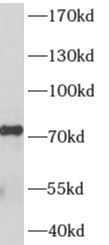Products
AKAP8L antibody
| Synonyms: | A-kinase anchor protein 8-like (AKAP8-like protein)|Helicase A-binding protein 95 (HAP95)|Homologous to AKAP95 protein (HA95)|Neighbor of A-kinase-anchoring protein 95 (Neighbor of AKAP95)|AKAP8L|NAKAP|NAKAP95 antibody | ||
| Catalogue No.: | FNab00258 | Reactivity: | Human |
| Host: | Rabbit | Tested Application: | ELISA, WB, IF |
| Clonality: | polyclonal | Isotype: | IgG |
| Size | Price |
|---|---|
| 100µg | Inquiry |
- SPECIFICATIONS
- FIGURES
- CONDITIONS
- FAQS
- Product Name
- AKAP8L antibody
- Catalogue No.
- FNab00258
- Size
- 100μg
- Form
- liquid
- Purification
- Immunogen affinity purified
- Purity
- ≥95% as determined by SDS-PAGE
- Clonality
- polyclonal
- Isotype
- IgG
- Storage
- PBS with 0.02% sodium azide and 50% glycerol pH 7.3, -20℃ for 12 months(Avoid repeated freeze / thaw cycles.)
- Immunogen
- A kinase(PRKA) anchor protein 8-like
- Alternative Names
- A-kinase anchor protein 8-like (AKAP8-like protein)|Helicase A-binding protein 95 (HAP95)|Homologous to AKAP95 protein (HA95)|Neighbor of A-kinase-anchoring protein 95 (Neighbor of AKAP95)|AKAP8L|NAKAP|NAKAP95 antibody
- UniProt ID
- Q9ULX6
- Observed MW
- 72 kDa
- Tested Applications
- ELISA, WB, IF
- Recommended dilution
- WB: 1:200-1:2000; IF: 1:20-200
 PC-3 cells were subjected to SDS PAGE followed by western blot with FNab00258(AKAP8L Antibody) at dilution of 1:300
PC-3 cells were subjected to SDS PAGE followed by western blot with FNab00258(AKAP8L Antibody) at dilution of 1:300
- Background
- Could play a role in constitutive transport element(CTE)-mediated gene expression by association with DHX9. Increases CTE-dependent nuclear unspliced mRNA export(PubMed:10748171, PubMed:11402034). Proposed to target PRKACA to the nucleus but does not seem to be implicated in the binding of regulatory subunit II of PKA(PubMed:10761695, PubMed:11884601). May be involved in nuclear envelope breakdown and chromatin condensation. May be involved in anchoring nuclear membranes to chromatin in interphase and in releasing membranes from chromating at mitosis(PubMed:11034899). May regulate the initiation phase of DNA replication when associated with TMPO isoform Beta(PubMed:12538639). Required for cell cycle G2/M transition and histone deacetylation during mitosis. In mitotic cells recruits HDAC3 to the vicinity of chromatin leading to deacetylation and subsequent phosphorylation at 'Ser-10' of histone H3; in this function seems to act redundantly with AKAP8(PubMed:16980585). May be involved in regulation of pre-mRNA splicing(PubMed:17594903). (Microbial infection) In case of EBV infection, may target PRKACA to EBNA-LP-containing nuclear sites to modulate transcription from specific promoters(PubMed:11884601). Can synergize with DHX9 to activate the CTE-mediated gene expression of type D retroviruses(PubMed:11402034). In case of HIV-1 infection, involved in the DHX9-promoted annealing of host tRNA(Lys3) to viral genomic RNA as a primer in reverse transcription; in vitro negatively regulates DHX9 annealing activity(PubMed:25034436).
How many times can antibodies be recycled?
First, usually it's not suggested to recycle antibodies. After use, buffer system of antibodies has changed. The storage condition of recycled antibodies for different customers also varies. Thus, the performance efficiency of recycled antibodies can’t be guaranteed. Besides, FineTest ever conducted the antibody recycling assay. Assay results show recycling times of different antibodies also varies. Usually, higher antibody titer allows more repeated use. Customers can determine based on experimental requirements.
Notes: After incubation, we recycle rest antibodies to centrifuge tube and store at 4℃. High titer antibodies can be stored for a minimum of one week. Reuse about three times.
What are components of FineTest antibody buffer?
Components of FineTest antibody buffer are usually PBS with proclin300 or sodium azide, BSA, 50% glycerol. Common preservative is proclin300 or sodium azide, which is widely applied in the lab and industry.
How about the storage temperature and duration of FineTest antibodies?
Most antibodies are stored at -20℃. Directly-labeled flow cytometry antibodies should be stored at 2 - 8℃. The shelf life is one year. If after sales issues for purchased antibodies appear, return or replacement is available. Usually, antibodies can be still used after the one-year warranty. We can offer technical support services.
Is dilution required for FineTest antibodies? What’s the dilute solution?
Directly-labeled flow cytometry antibodies are ready-to-use without dilution. Other antibodies are usually concentrated. Follow the dilution ratio suggested in the manual. Dilute solution for different experiments also varies. Common antibody dilution buffers are acceptable(e.g. PBST, TBST, antibody blocking buffer).
How to retrieve antibodies for immunohistochemistry?
Common retrieval buffers: Tris-EDTA Buffer(pH 9.0); Citrate Buffer(pH 6.0)
Heat induced antibody retrieval:
Method 1: Water-bath heating: Put the beaker with retrieval buffer and slide in the boiling water bath. Keep the boiling state for 15min. Naturally cool to room temperature;
Method 2: Microwave retrieval: Put the beaker with retrieval buffer and slide in the microwave oven. Heat at high power for 5min, Switch OFF for 3min, Heat at medium power for 5min. Naturally cool to room temperature.
How to choose secondary antibodies?
(1) Secondary antibodies react with primary antibodies. Thus, secondary antibodies should be against host species of primary antibodies. E.g. If the primary antibody is derived from rabbit, the relevant secondary antibody should be against rabbit. E.g. goat anti rabbit or donkey anti rabbit.
(2) Choose secondary antibody conjugates according to the experimental type, e.g. ELISA, WB, IHC etc. Common enzyme conjugated secondary antibodies are labelled by HRP, AP etc. Fluorescin or dye labelled secondary antibodies are applied in immunofluorescence and flow cytometry(e.g. FITC, Cy3).
